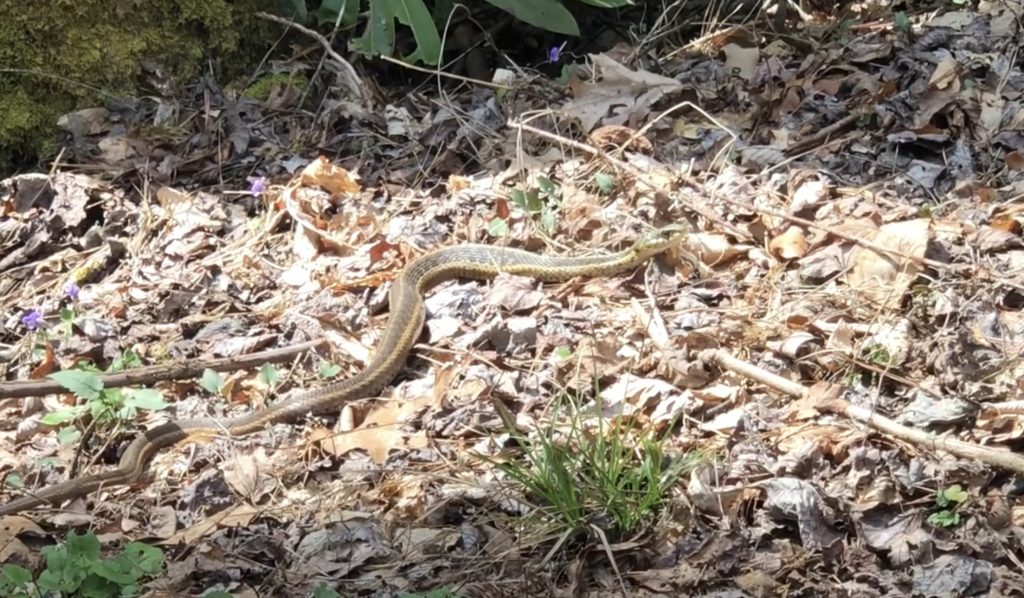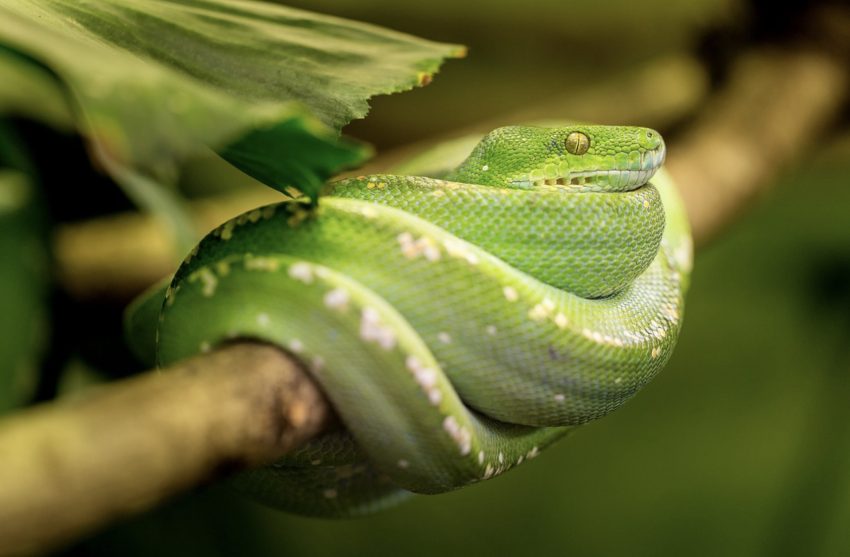The Importance of Knowing What to Do When Encountering a Snake on a Hiking Trail
It’s estimated that there are over 3,000 species of snakes worldwide and many of them can be found in areas where people hike. In fact, it’s not uncommon for hikers to encounter snakes while on the trail.
While some snakes are harmless and pose no threat to humans, others are venomous and can cause serious harm if they bite someone. Therefore knowing how to react appropriately when encountering a snake on the trail can literally be life-saving!
Stay Calm
Let me start by saying I am not a snake person. I don’t like them nor do I want to be around them no matter the situation. From experience, encountering a snake on trail can be a scary experience, but it’s important to remain calm and avoid panicking. Snakes typically only attack when they feel threatened, so any sudden movements or loud noises can increase the chances of the snake feeling threatened and attacking.
If you encounter a snake, try to take deep breaths and focus on keeping your heart rate down. Remember that most snakes are not aggressive unless provoked.
If you feel yourself starting to panic, take a moment to assess the situation. Look at the snake from a safe distance and try to determine if it is venomous or not.
While this might seem like an impossible task for someone without experience in identifying snakes, there are some general characteristics that can help you differentiate between venomous and non-venomous snakes. Venomous snakes typically have triangular-shaped heads and slit-like pupils in their eyes, while non-venomous snakes have round pupils.
It’s essential to keep in mind that while it’s natural to be scared when encountering a snake on the trail, staying calm will allow you to react rationally and safely without escalating the situation. Remember that these creatures are simply going about their daily life, just like you are enjoying your hike!

Give the Snake Space
Encountering a snake while on a hiking trail can be an unnerving experience. However, it’s important to remember that snakes are territorial creatures and typically only attack when they feel threatened. Therefore, when you come across a snake, the best thing to do is give it plenty of space to retreat.
As a general rule of thumb, hikers should stay at least six feet away from any snake they encounter. This distance will allow the snake to feel safe and secure enough to move away from the area without feeling threatened or provoked.
When giving the snake space, it’s also important to avoid making sudden movements or loud noises that may startle or provoke it. By giving snakes their necessary space, hikers can prevent themselves from accidentally provoking them into feeling threatened or attacking in self-defense.
Remember that snakes are not naturally aggressive and would only attack if provoked or threatened. So if you find yourself in close proximity with a snake while hiking, try not to panic and slowly back away while giving it enough room to escape without feeling scared or cornered.
Why Snakes Attack
Many people assume that snakes are naturally aggressive creatures who seek out human prey for their next meal. However, this couldn’t be further from the truth! In reality, snakes usually only attack humans as a last resort when they feel trapped or threatened.
When encountering humans on their territory (such as on hiking trails), snakes may feel agitated and scared by their presence; this can lead them to strike out in self-defense if they believe they are being directly threatened (such as someone walking towards them). It’s therefore crucial for hikers always to give these animals plenty of space whenever possible- so everyone stays safe!
Identify the Snake
Identifying the type of snake you have encountered is critical in order to determine whether it’s venomous or non-venomous. Knowing this information can inform your decision-making on how best to proceed in avoiding or removing the snake from your path. It’s important to note that researching the area you are hiking can help you identify the snakes in the area. Usually when visiting a new National Park or park in general. I like to go to the nature center to see what type of wildlife we could encounter and to take appropriate precautions.
Provide a few tips for identifying common types of snakes (e.g., rattlesnakes have distinctive rattles on their tails).
There are several physical characteristics that can help hikers identify common types of snakes they may encounter on hiking trails. For example, rattlesnakes are known for their distinctive rattle sound located at the end of their tail. Copperheads typically have hourglass-shaped patterns along their body and triangular-shaped heads.
Cottonmouths have white inner mouths when they open them in defense mode. Coral snakes have bright colors arranged in specific patterns along their body.
By familiarizing yourself with these identifying features before hitting the trails you will feel more confident and prepared in case you encounter a snake on your hike. Remember, if you’re not sure what type of snake you’re dealing with always err on the side of caution and give them plenty of space by slowly backing away until they’ve retreated from plain sight or moved off trail entirely so you can safely continue your hike without any risk to yourself or the animals.
Back Away Slowly
Encountering a venomous snake on the trail can be a scary experience, but it’s important to remain calm and remember that most snakes won’t attack unless they feel threatened. If you do come across a venomous snake, the best course of action is to slowly back away in the opposite direction. Avoid any sudden movements that could startle or provoke the snake.
When backing away from a snake, it’s important to take small, deliberate steps and avoid turning your back on the snake. Keep your eyes fixed on the snake and maintain a safe distance as you move away.
It’s also a good idea to move sideways rather than backwards if possible, as this gives you better visibility of your surroundings and makes it easier to keep an eye on the snake. Remember that just because you’ve spotted one venomous snake doesn’t necessarily mean there aren’t others nearby.
Take care not to step on or disturb any other snakes as you move away from the area. Once you’ve put some distance between yourself and the snake, take a few deep breaths to calm yourself down before continuing with your hike.
Suggest taking small steps
If you try to run or panic when encountering a venomous snake, it will only make things worse by increasing your heart rate and blood pressure which can cause more harm than good in this situation. Instead of trying to outrun or fight off the snakes, calmly back away from them using small steps. Taking small steps will also help in keeping an eye on other surrounding areas where more snakes may be present if there are any.
Even if there are no visible signs of danger nearby it is still important not turn your back on them because they may follow up with an attack if they feel provoked further so always be alert while moving away from venomous snakes. Once you’re at a safe distance from the animal, take a few moments to catch your breath and evaluate the situation before proceeding with your hike.
Remember that snakes are an important part of the ecosystem and they have their own role to play in the environment, so it’s important to respect them and give them plenty of space. When hiking in areas where venomous snakes are common, always be aware of your surroundings and stay alert at all times to avoid any unwanted encounters.
Wait for the Snake to Move On
Let the Snake Have Its Space and Time
Sometimes, it’s not possible to back away slowly from a snake because it could be blocking your path. If that is the case, then wait for the snake to move on its own.
Snakes are sensitive creatures and can detect your presence through vibrations in the ground or changes in temperature. If they feel threatened or uncomfortable, they will eventually move away on their own.
Be Patient and Stay Calm
Waiting for a snake to move can be nerve-wracking, but you must remain patient and calm during this time. Don’t try to rush the process by throwing anything at the snake or making loud noises that might scare it further.
Remember that you’re in its territory – we’re just visitors here – so give it as much space as possible while waiting for it to leave. Keeping a safe distance is key as you never know how long it may take for them to feel comfortable enough to move along.
Remind Hikers Not To Throw Anything
Avoid Provoking The Snake
As you wait for the snake to move on, keep in mind that throwing something at it will only make matters worse. Doing so can provoke an already nervous animal and cause them to become more aggressive than before. Remember that snakes don’t mean any harm unless they feel threatened; therefore, let nature take its course without interfering.
Show Respect And Appreciation For All Wildlife
Remember that snakes play a vital role in maintaining our ecosystem by controlling rodent populations and serving as prey for other animals like birds of prey or coyotes. Show respect towards these creatures by refraining from harming them even when they have crossed your path on a hike.
Encountering snakes while hiking can be a scary experience, but it doesn’t have to be. Remember to stay calm, give the snake plenty of space and time to move on its own if possible, and avoid throwing anything at it.
By following these simple steps, you can safely coexist with snakes while enjoying all the beauty that nature has to offer. Additionally, always remember that we share this planet with all creatures great and small – let us celebrate their presence instead of fearing them! Happy Hiking!
